
A tetrapod is any four-limbed vertebrate animal of the superclass Tetrapoda. Tetrapods include all extant and extinct amphibians and amniotes, with the latter in turn evolving into two major clades, the sauropsids and synapsids. Some tetrapods such as snakes, legless lizards, and caecilians had evolved to become limbless via mutations of the Hox gene, although some do still have a pair of vestigial spurs that are remnants of the hindlimbs.

Ichthyostega is an extinct genus of limbed tetrapodomorphs from the Late Devonian of what is now Greenland. It was among the earliest four-limbed vertebrates ever in the fossil record and was one of the first with weight-bearing adaptations for terrestrial locomotion. Ichthyostega possessed lungs and limbs that helped it navigate through shallow water in swamps. Although Ichthyostega is often labelled a 'tetrapod' because of its limbs and fingers, it evolved long before true crown group tetrapods and could more accurately be referred to as a stegocephalian or stem tetrapod. Likewise, while undoubtedly of amphibian build and habit, it is not a true member of the group in the narrow sense, as the first modern amphibians appeared in the Triassic Period. Until finds of other early stegocephalians and closely related fishes in the late 20th century, Ichthyostega stood alone as a transitional fossil between fish and tetrapods, combining fish and tetrapod features. Newer research has shown that it had an unusual anatomy, functioning more akin to a seal than a salamander, as previously assumed.
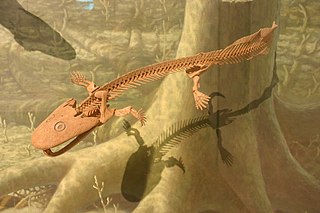
Acanthostega is an extinct genus of stem-tetrapod, among the first vertebrate animals to have recognizable limbs. It appeared in the late Devonian period about 365 million years ago, and was anatomically intermediate between lobe-finned fishes and those that were fully capable of coming onto land.

Dunkleosteus is an extinct genus of large arthrodire ("jointed-neck") fish that existed during the Late Devonian period, about 382–358 million years ago. It was a pelagic fish inhabiting open waters, and one of the first apex predators of any ecosystem.

Hynerpeton is an extinct genus of early four-limbed vertebrate that lived in the rivers and ponds of Pennsylvania during the Late Devonian period, around 365 to 363 million years ago. The only known species of Hynerpeton is H. bassetti, named after the describer's grandfather, city planner Edward Bassett. Hynerpeton is known for being the first Devonian four-limbed vertebrate discovered in the United States, as well as possibly being one of the first to have lost internal (fish-like) gills.

Venaticosuchus is a genus of pseudosuchian archosaurs from the family Ornithosuchidae. Known from a single species, Venaticosuchus rusconii, this genus is described based on an incomplete skull and jaw collected from the Late Triassic (Carnian) Ischigualasto Formation in the Ischigualasto-Villa Unión Basin in northwestern Argentina, which was deposited around 230 million years ago. This fossil material has been termed the holotype specimen PVL 2578. Venaticosuchus incorporated a myriad of features present in the other two genera of ornithosuchids, Ornithosuchus and Riojasuchus. However, it also had several unique traits, relating to the lower jaw.

Ventastega is an extinct genus of stem tetrapod that lived during the Upper Fammenian of the Late Devonian, approximately 372.2 to 358.9 million years ago. Only one species is known that belongs in the genus, Ventastega curonica, which was described in 1996 after fossils were discovered in 1933 and mistakenly associated with a fish called Polyplocodus wenjukovi. ‘Curonica’ in the species name refers to Curonia, the Latin name for Kurzeme, a region in western Latvia. Ventastega curonica was discovered in two localities in Latvia, and was the first stem tetrapod described in Latvia along with being only the 4th Devonian tetrapodomorph known at the time of description. Based on the morphology of both cranial and post-cranial elements discovered, Ventastega is more primitive than other Devonian tetrapodomorphs including Acanthostega and Ichthyostega, and helps further understanding of the fish-tetrapod transition.

Eusthenodon is an extinct genus of tristichopterid tetrapodomorphs from the Late Devonian period, ranging between 383 and 359 million years ago. They are well known for being a cosmopolitan genus with remains being recovered from East Greenland, Australia, Central Russia, South Africa, Pennsylvania, and Belgium. Compared to the other closely related genera of the Tristichopteridae clade, Eusthenodon was one of the largest lobe-finned fishes and among the most derived tristichopterids alongside its close relatives Cabonnichthys and Mandageria.

Colosteidae is a family of stegocephalians that lived in the Carboniferous period. They possessed a variety of characteristics from different tetrapod or stem-tetrapod groups, which made them historically difficult to classify. They are now considered to be part of a lineage intermediate between the earliest Devonian terrestrial vertebrates, and the different groups ancestral to all modern tetrapods, such as temnospondyls and reptiliomorphs.
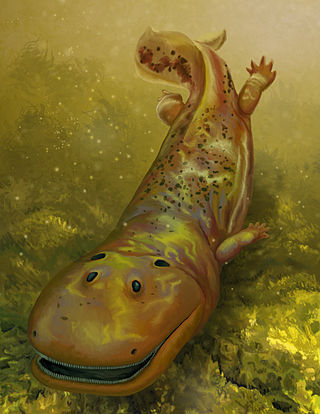
Spathicephalus is an extinct genus of stem tetrapods that lived during the middle of the Carboniferous Period. The genus includes two species: the type species S. mirus from Scotland, which is known from two mostly complete skulls and other cranial material, and the species S. pereger from Nova Scotia, which is known from a single fragment of the skull table. Based on the S. mirus material, the appearance of Spathicephalus is unlike that of any other early tetrapod, with a flattened, square-shaped skull and jaws lined with hundreds of very small chisel-like teeth. However, Spathicephalus shares several anatomical features with a family of stem tetrapods called Baphetidae, leading most paleontologists who have studied the genus to place it within a larger group called Baphetoidea, often as part of its own monotypic family Spathicephalidae. Spathicephalus is thought to have fed on aquatic invertebrates through a combination of suction feeding and filter feeding.
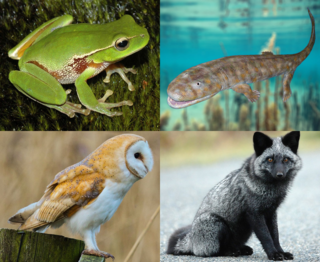
Stegocephali is a clade of vertebrate animals containing all fully limbed tetrapodomorphs. It is equivalent to a broad definition of the superclass Tetrapoda: under this broad definition, the term "tetrapod" applies to any animal descended from the first vertebrate with four limbs each with five digits in the extremity (pentadactyly), rather than fins of their sarcopterygian relatives.

Ichthyostegalia is an order of extinct amphibians, representing the earliest landliving vertebrates. The group is thus an evolutionary grade rather than a clade. While the group are recognized as having feet rather than fins, most, if not all, had internal gills in adulthood and lived primarily as shallow water fish and spent minimal time on land.
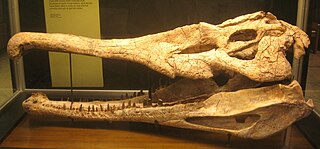
Brachysuchus is an extinct genus of phytosaur known from the late Triassic period of Dockum Group in Texas, United States. It is known from the holotype UMMP 10336 is composed of a skull, lower jaws and partial postcranium and from the associated paratype UMMP 14366, nearly complete skull, recovered from the 'Pre-Tecovas Horizon' in the Dockum Group. It was first named by Case in 1929 and the type species is Brachysuchus megalodon. Its closest relative was Angistorhinus. However, its rostral crest was much smaller than that of Angistorhinus, and the rostrum as a whole is shorter and thicker.
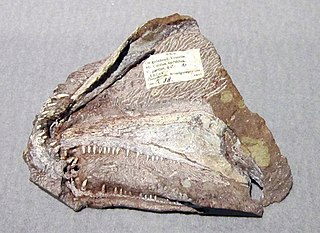
Ymeria is an extinct genus of early stem tetrapod from the Devonian of Greenland. Of the two other genera of stem tetrapods from Greenland, Acanthostega and Ichthyostega, Ymeria is most closely related to Ichthyostega, though the single known specimen is smaller, the skull about 10 cm in length. A single interclavicle resembles that of Ichthyostega, an indication Ymeria may have resembled this genus in the post-cranial skeleton.

Most bony fishes have two sets of jaws made mainly of bone. The primary oral jaws open and close the mouth, and a second set of pharyngeal jaws are positioned at the back of the throat. The oral jaws are used to capture and manipulate prey by biting and crushing. The pharyngeal jaws, so-called because they are positioned within the pharynx, are used to further process the food and move it from the mouth to the stomach.

The evolution of fish began about 530 million years ago during the Cambrian explosion. It was during this time that the early chordates developed the skull and the vertebral column, leading to the first craniates and vertebrates. The first fish lineages belong to the Agnatha, or jawless fish. Early examples include Haikouichthys. During the late Cambrian, eel-like jawless fish called the conodonts, and small mostly armoured fish known as ostracoderms, first appeared. Most jawless fish are now extinct; but the extant lampreys may approximate ancient pre-jawed fish. Lampreys belong to the Cyclostomata, which includes the extant hagfish, and this group may have split early on from other agnathans.

Gordodon is an extinct genus of non-mammalian synapsid that lived during the Early Permian of what is now Otero County, New Mexico. It was a member of the herbivorous sail-backed family Edaphosauridae and contains only a single species, the type species G. kraineri. Gordodon is unusual among early synapsids for its teeth, which were arranged similarly to those of modern mammals and unlike the simple, uniform lizard-like teeth of other early herbivorous synapsids. Gordodon had large incisor-like teeth at the front, followed by a prominent gap between them and a short row of peg-like teeth at the back. Gordodon was also relatively long-necked for an early synapsid, with elongated and gracile vertebrae in its neck and back. Like other edaphosaurids, Gordodon had a tall sail on its back made from the bony neural spines of its vertebrae. The spines also had bony knobs on them, a common trait of edaphosaurids, but the knobs of Gordodon are also unique for being more slender, thorn-like and randomly arranged along the spines. It is estimated to have been rather small at 1 m in length excluding the tail and 34 kg (75 lb) in weight.

Elginerpetontidae is an extinct family of basal stegocephalian tetrapodomorphs which lived in Europe during the Frasnian stage of the Late Devonian epoch. It contains the genera Elginerpeton, Obruchevichthys and Webererpeton.
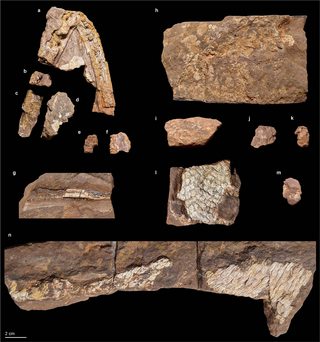
Qikiqtania is an extinct genus of elpistostegalian tetrapodomorph from the Late Devonian Fram Formation of Nunavut, Canada. The genus contains a single species, Q. wakei, known from a partial skeleton. Analysis of the fin bones suggests that Qikiqtania was well-suited to swimming, and likely incapable of walking or supporting itself out of the water, as has been suggested for the closely related Tiktaalik.
Brittagnathus is an extinct genus of four-limbed vertebrate ("tetrapod") from the Late Devonian of Greenland. It contains a single species, Brittagnathus minutus, which is based on a complete lower jaw recovered from an Acanthostega bonebed in the Britta Dal Formation. It is the fourth named genus of "tetrapod" from the Late Devonian of Greenland, after Ichthyostega, Acanthostega, and Ymeria.

























